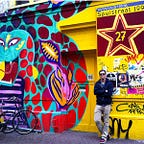The Work Of Guayasamin
The style is distinct; you might know the work of Oswaldo Guayasamin without thinking you do. His paintings are reminiscent of caricatures — long features, long fingers, deep shadows, wide mouths and eyes, lines in the skin like routes on a map, and almost always a strong emotion such as anguish or compassion.
His work revolves around the suffering of the indigenous people of South America, though he has works dedicated to the pain of the victims of various wars, struggles, violence around the world. I think this is what struck me the most: Here’s a man who had an entire universe of pain to draw from in his home nation of Ecuador, and his home continent at large — and he mostly does — but he was not blind, or did not turn away from, the suffering of people in places like Vietnam, the Czech Republic or Spain. He recognized the fear, anger and hope in all of those places and expressed it in his paintings.
His work comes mainly in three periods: The Trail of Tears, the Age of Rage and The Tenderness, and in each painting there is no mistaking in what state he worked. He gives a voice to the downtrodden masses in the first; explodes with fury over injustice in the second; recognizes the peace and love of family in the final.
During a trip I took to his house, which is in the breathtaking neighborhood (I mean this literally, it’s quite high up) of Bellavista overlooking Quito, I watched a video of Guayasamin painting a portrait of Paco de Lucia, a famous flamenco guitar player. It is clearly one of Guayasamin’s least, shall we say, inspired works: It’s just a painting of a dude who he knows and is really good at guitar. It lacks the urgency of message that his more famous works provide.
And yet the video gave a glimpse into Guayasamin’s methods, as well as how he translates his feelings to the canvas. Though de Lucia isn’t particularly tall or gaunt or bigheaded, Guayasamin gives him a long, skinny head that stretches throughout the painting — and he does so, according to the man himself, because he sensed the man’s great musical capacity was like a “tower” inside of him. He painted him like a cathedral to match the regal and majestic vibe. You can actually watch the video here:
He apparently painted the whole thing in about an hour.
Though this lacks the underlying themes of his other work, I felt here the swift, persistent earnestness of his style. It emanates throughout everything else he made.
Alongside Guayasamin’s house, which now functions as a museum for his work and for others, is La Capilla del Hombre, the Chapel of Man, which was completed after he died in 1999. The $8 entrance fee gives you access to both (plus gardens and other areas), and the Chapel does an outstanding job of capturing both his agony over the past and his hope for the future. Work from all three of his periods, plus an “eternal flame” are inside.
I understood his anguish (as much as a gringo can), though I found his hope perplexing. How could he maintain hope in the face of perpetual destruction, worldwide? Perhaps that’s the cynic in me, the cynic that has not yet embraced “The Tenderness.” But it made this quote, which was painted in giant letters, all the more powerful:
Mantengan encendida una luz que siempre voy a volver
Which means,
“Keep a light burning for I will always return.”
I’ll try.
